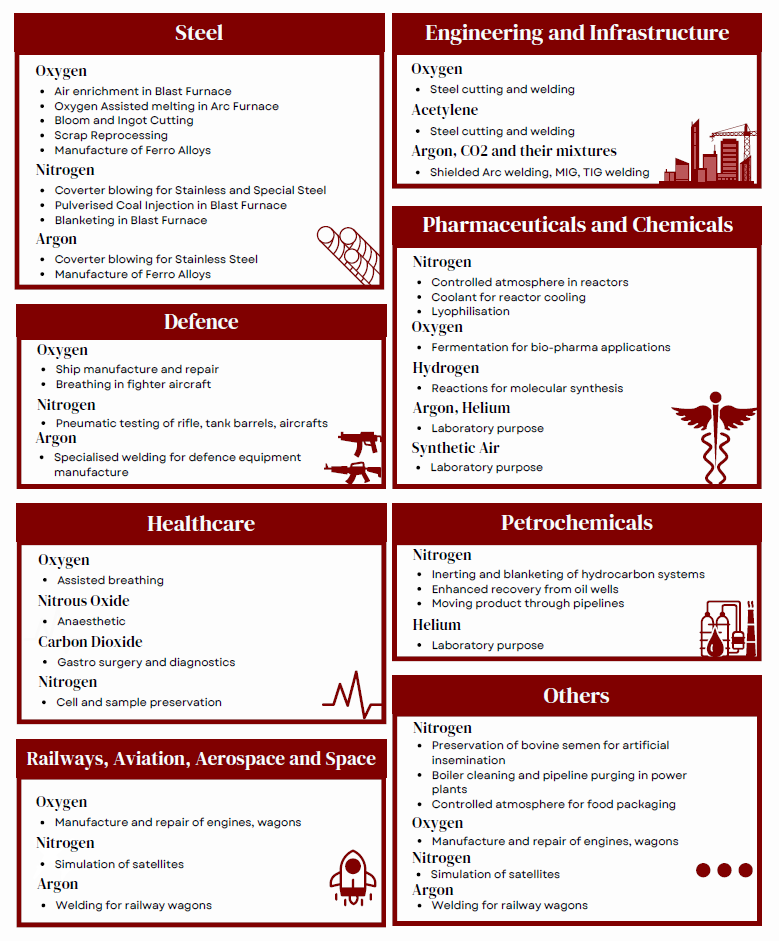- Chemicals – The chemical industry accounted for 19% of the global industrial gases demand by value in 2023, and 16.3% in India during the same period. Industrial gases like oxygen, nitrogen, and carbon dioxide are essential for various chemical production processes, supporting the manufacture of high-volume essentials such as ammonia and urea. For example, ammonia production, which is a key component of fertilizers, relies heavily on nitrogen. The Haber-Bosch process, used to synthesize ammonia from nitrogen and hydrogen, requires significant volumes of these gases. Moreover, industrial gases play a role in ensuring safety and efficiency in chemical plants. Nitrogen, for instance, is used for purging and blanketing to prevent unwanted chemical reactions and maintain inert atmospheres in storage tanks and reactors. This is crucial for maintaining product quality and ensuring operational safety.
- Steel and Other Metal Manufacturing – This sector accounted for 18.2% market share of global industrial gases market in 2023. In India, the market share of steel industry was 23.3%. All the gases play an important role in steel manufacturing process. Oxygen is blown into the molten pig iron to remove impurities like carbon, silicon, manganese, and phosphorus by oxidation, which is essential in converting pig iron into high-quality steel. Nitrogen has a solid solution strengthening effect and enhances steel’s hardenability. In nitrogen-containing ferritic steel, precipitation hardening occurs due to ultra-microscopic nitrides during tempering. N2 is commonly used as an alloying element in steel.
- Healthcare – The healthcare industry accounted for 11.9% of the global industrial gases industry by value in 2023. Gases like oxygen, nitrogen, carbon dioxide, helium, etc. find important functions in healthcare sector. Oxygen therapy is fundamental in medical settings to treat conditions such as hypoxia (low blood oxygen levels) and respiratory distress. Nitrous oxide has several medical uses, primarily in anaesthesia and pain management. Carbon dioxide is used in procedures like laparoscopy, etc. Helium is used in medical imaging and respiratory therapies. In India, healthcare industry accounted for 9.8% of the industrial gases market by value in 2023.
- Oil and Gas – The oil and gas industry accounted for 11.2% market share of global industrial gases demand by value in 2023. In India, the oil & gas industry accounted for 6.1% share of Indian industrial gases market by value in 2023. Key gases like hydrogen, carbon dioxide, nitrogen are essential for various refining processes. Hydrogen is very important for hydrocracking, hydrotreating, desulfurization, etc. Nitrogen is used for inerting and blanketing, purging, etc. applications. Carbon dioxide is utilized for enhanced oil recovery, pH control, cooling and fire suppression, etc.
- Manufacturing – The manufacturing industry accounted for 10.1% of global industrial gases demand by value in 2023. In India, it represented 12.9% of the total industrial gases demand in terms of value. Industrial gases such as oxygen, nitrogen, and argon play critical roles in various manufacturing processes, significantly contributing to the efficiency and quality of production in metal fabrication, engineering, and general manufacturing sectors. Oxygen is widely used in cutting, welding, and brazing operations. It enhances combustion efficiency, enabling precise cutting and welding, which are essential in the fabrication of steel structures, automotive components, and machinery. In the engineering sector, nitrogen is utilized for its inert properties, which are crucial in preventing oxidation and contamination during the production of sensitive electronic components and precision instruments.
- Food and Beverage – The food and beverage industry accounted for 9.8% of the industrial gases market by value globally in 2023. In India, the market share of F&B segment was around 9.2%. For better food preservation, high concentrations of nitrogen gas is required within food packaging. Nitrogen is also preferred for gas flushing which is helpful in longer food storage.

- Electrical and Electronics – The electrical and electronics industry accounted for 4.9% of the global industrial gases demand by value in 2023. Nitrogen is used in wave soldering machines and blanketing applications. Oxygen supports high temperature cutting processes used for shaping metals and alloys in manufacturing electronic components. In some electrical equipment, such as high-voltage switchgear and circuit breakers, argon is used as an insulating gas to improve dielectric strength and performance. Hydrogen is used in controlled atmospheres for annealing and heat treatment processes in semiconductor manufacturing. In India, electrical and electronics industry accounted for 4.1% of the industrial gases market by value in 2023.
- Infrastructure – The infrastructure industry accounted for 4% of the global and Indian industrial gases demand by value in 2023. Industrial gases like oxygen and acetylene are used in oxy-fuel welding and cutting applications. Argon and carbon dioxide are utilized as shielding gas in welding processes like tungsten inert gas welding and metal inert gas welding.
- Pharmaceutical – The pharma industry accounted for 3% of the global industrial gases demand by value in 2023 and for India, it accounted for 4.9% of the demand as per value in the same year. Nitrogen is used for inerting, blanketing, and purging to maintain an oxygen-free environment, crucial for the stability of sensitive compounds. Carbon dioxide is employed in supercritical fluid extraction to obtain pure and high-quality active pharmaceutical ingredients. Oxygen is used in fermentation processes for antibiotic production. The growth of the pharmaceutical industry, driven by increased healthcare spending and innovation in drug development, leads to a higher demand for industrial gases.
- Aerospace and Defence – The industries together accounted for 2% of the global industrial gases demand by value in 2023 and for India, it accounted for 2.3% of the demand in terms of value in the same year. Oxygen, argon, and helium are used in metal fabrication and welding applications. Hydrogen is utilized in rocket propulsion systems as a fuel source. Oxygen is also used as an oxidizer in rocket engines to support combustion of fuels.
